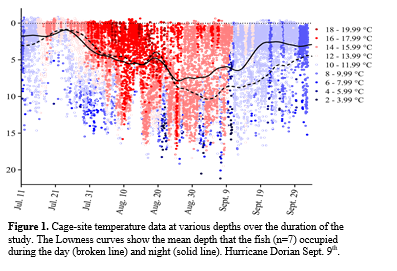ATLANTIC SALMON Salmo salar CAGE-SITE DISTRIBUTION, BEHAVIOUR AND PHYSIOLOGY MEASURED DURING A NEWFOUNDLAND HEAT WAVE USING DATA LOGGERS
Increasing water temperatures and reduced oxygen levels due to climate change are a challenge for fish reared in cage-sites in coastal regions. In addition, the frequency and severity of storms, heat waves and ‘cold events’ can increase temperature variability, and pose significant additional challenges. The Atlantic salmon industry must adapt to these challenges to grow sustainability, and thus, a better understanding of how sea-cage conditions affect fish physiology and behaviour under such conditions is needed.
Salmon (~2.5 kg) in a sea-cage on the south coast of Newfoundland were fitted with Star-Oddi milli-HRT ACT and milli-TD data loggers in the summer of 2019. These tags continuously recorded the fish’s 3D acceleration (i.e., activity/behaviour), electrocardiograms (used to determine heart rate and heart rate variability), depth and temperature from early July to mid-October.
Surface water temperatures ranged from ~10-12 to 18-19.5°C over the summer/ early fall, and then abruptly fell to 8-10°C after hurricane Dorian passed over the region. The fish typically selected temperatures of 14-18°C during the warmest weeks of the summer (the maximum temperatures experienced by the fish 19.3 ± 0.05oC), but used the full range of depths available during this period. Heart rate and depth were greater during the day, and activity and the proportion of time spent non-steady swimming increased when feeding was stopped at high temperatures.
These data show that data loggers can be used effectively to map environmental conditions throughout salmon sea-cages, and to determine how conditions and management decisions impact the behaviour and physiology of fish. Thus, they can provide important insights into fish health and welfare, and in combination with lab-based studies, valuable information about what conditions are a concern with regard to the increased risk of moralities / mortality events.
Further advancements in this technology, including the development of tags with extended battery life and acoustic transmission capabilities, could make it suitable for integration into industry cage-site monitoring programs.
